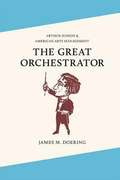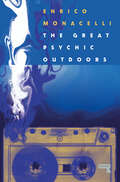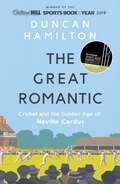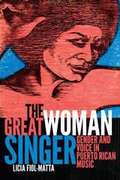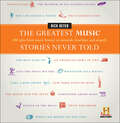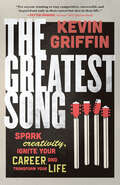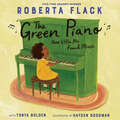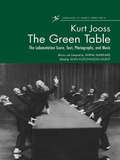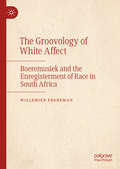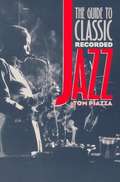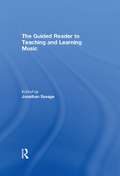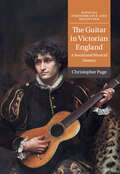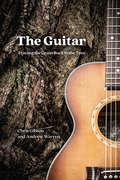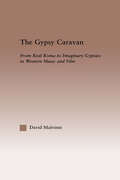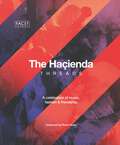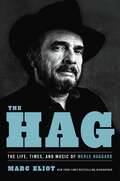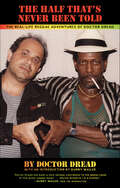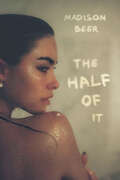- Table View
- List View
The Great Orchestrator: Arthur Judson and American Arts Management (Music in American Life)
by James M. DoeringThis biography charts the career and legacy of the pioneering American music manager Arthur Judson (1881-1975), who rose to prominence in Philadelphia and New York at the beginning of the twentieth century. A violinist by training, Judson became manager of the Philadelphia Orchestra in 1915 under the iconic conductor Leopold Stokowski. Within a few years, Judson also took on management of the New York Philharmonic, navigating a period of change and the tenures of several important conductors who included William Mengelberg, Arturo Toscanini, and John Barbirolli. Judson also began managing individual artists, including pianists Alfred Cortot and Vladimir Horowitz, violinist Jasha Heifetz, and cellist Gregor Piatigorsky. He also organized the U.S. tours of several prominent composers, including Igor Stravinsky and Vincent d'Indy. At the same time, Judson began managing conductors. His first clients were Stokowski and Fritz Reiner. By the 1930s, Judson's conductor list included most of the important conductors working in America. Drawing on rich correspondence between Judson and the conductors and artists he served, James M. Doering demonstrates Judson's multifaceted roles, including involvement with programming choices, building audiences, negotiating with orchestra members and their unions, and exploring new technologies for extending the orchestras' reach. In addition to his colorful career behind the scenes at two preeminent American orchestras, Judson was important for a number of innovations in arts management. In 1922, he founded a nationwide network of local managers and later became involved in the relatively unexplored medium of radio, working first with WEAF in New York City and then later forming his own national radio network in 1927. Providing valuable insight into the workings of these orchestras and the formative years of arts management, The Great Orchestrator is a valuable portrait of one of the most powerful managers in American musical history.
The Great Psychic Outdoors: Adventures in Low Fidelity
by Enrico MonacelliExplores the weird world of lo-fi music to investigate its revolutionary potential and its ability to subvert what we think music can do.Homemade records, tape-hiss worship and a taste for a very peculiar kind of psychedelia have carved themselves a weird niche in the contemporary musical landscape under the name of lo-fi.This genreless genre, characterized by poor recordings and rough sounds, spanning from the most extreme heavy metal to the sweetest ear-candies pop can offer, has become a solid presence in our collective sensibility. And yet, it has largely been neglected: this staunch refusal of anything hi-fi and hi-tech has fallen under the radar of the categories we use to analyse ourselves and our times.The Great Psychic Outdoors, dedicated to the most interesting and controversial artists in this movement, will rectify this injustice and vindicate the revolutionary potential of lo-fi music, engaging with this weird genre on its own terms and facing head on the contradictions and possibilities of this multi-faceted phenomenon. Confronting the aesthetic and conceptual stakes of this sonic craft, The Great Psychic Outdoors shows what lo-fi says about us, our lives under capitalism and the strange ways we cope with pain, madness and beauty.
The Great Romantic: Cricket and the golden age of Neville Cardus
by Duncan HamiltonNeville Cardus described how one majestic stroke-maker 'made music' and 'spread beauty' with his bat. Between two world wars, he became the laureate of cricket by doing the same with words.In The Great Romantic, award-winning author Duncan Hamilton demonstrates how Cardus changed sports journalism for ever. While popularising cricket - while appealing, in Cardus' words to people who 'didn't know a leg-break from the pavilion cat at Lord's'- he became a star in his own right with exquisite phrase-making, disdain for statistics and a penchant for literary and musical allusions. Among those who venerated Cardus were PG Wodehouse, John Arlott, Harold Pinter, JB Priestley and Don Bradman. However, behind the rhapsody in blue skies, green grass and colourful characters, this richly evocative biography finds that Cardus' mother was a prostitute, he never knew his father and he received negligible education. Infatuations with younger women ran parallel to a decidedly unromantic marriage. And, astonishingly, the supreme stylist's aversion to factual accuracy led to his reporting on matches he never attended. Yet Cardus also belied his impoverished origins to prosper in a second class-conscious profession, becoming a music critic of international renown. The Great Romantic uncovers the dark enigma within a golden age.
The Great Romantic: Cricket and the golden age of Neville Cardus - Winner of the William Hill Sports Book of the Year
by Duncan HamiltonNeville Cardus described how one majestic stroke-maker 'made music' and 'spread beauty' with his bat. Between two world wars, he became the laureate of cricket by doing the same with words.In The Great Romantic, award-winning author Duncan Hamilton demonstrates how Cardus changed sports journalism for ever. While popularising cricket - while appealing, in Cardus' words to people who 'didn't know a leg-break from the pavilion cat at Lord's'- he became a star in his own right with exquisite phrase-making, disdain for statistics and a penchant for literary and musical allusions. Among those who venerated Cardus were PG Wodehouse, John Arlott, Harold Pinter, JB Priestley and Don Bradman. However, behind the rhapsody in blue skies, green grass and colourful characters, this richly evocative biography finds that Cardus' mother was a prostitute, he never knew his father and he received negligible education. Infatuations with younger women ran parallel to a decidedly unromantic marriage. And, astonishingly, the supreme stylist's aversion to factual accuracy led to his reporting on matches he never attended. Yet Cardus also belied his impoverished origins to prosper in a second class-conscious profession, becoming a music critic of international renown. The Great Romantic uncovers the dark enigma within a golden age.
The Great Romantic: Cricket and the golden age of Neville Cardus - Winner of the William Hill Sports Book of the Year
by Duncan HamiltonNeville Cardus described how one majestic stroke-maker 'made music' and 'spread beauty' with his bat. Between two world wars, he became the laureate of cricket by doing the same with words.In The Great Romantic, award-winning author Duncan Hamilton demonstrates how Cardus changed sports journalism for ever. While popularising cricket - while appealing, in Cardus' words to people who 'didn't know a leg-break from the pavilion cat at Lord's'- he became a star in his own right with exquisite phrase-making, disdain for statistics and a penchant for literary and musical allusions. Among those who venerated Cardus were PG Wodehouse, John Arlott, Harold Pinter, JB Priestley and Don Bradman. However, behind the rhapsody in blue skies, green grass and colourful characters, this richly evocative biography finds that Cardus' mother was a prostitute, he never knew his father and he received negligible education. Infatuations with younger women ran parallel to a decidedly unromantic marriage. And, astonishingly, the supreme stylist's aversion to factual accuracy led to his reporting on matches he never attended. Yet Cardus also belied his impoverished origins to prosper in a second class-conscious profession, becoming a music critic of international renown. The Great Romantic uncovers the dark enigma within a golden age.
The Great Woman Singer: Gender and Voice in Puerto Rican Music
by Licia Fiol-MattaLicia Fiol-Matta traces the careers of four iconic Puerto Rican singers—Myrta Silva, Ruth Fernández, Ernestina Reyes, and Lucecita Benítez—to explore how their voices and performance style transform the possibilities for comprehending the figure of the woman singer. Fiol-Matta shows how these musicians, despite seemingly intractable demands to represent gender norms, exercised their artistic and political agency by challenging expectations of how they should look, sound, and act. Fiol-Matta also breaks with conceptualizations of the female pop voice as spontaneous and intuitive, interrogating the notion of "the great woman singer" to deploy her concept of the "thinking voice"—an event of music, voice, and listening that rewrites dominant narratives. Anchored in the work of Lacan, Foucault, and others, Fiol-Matta's theorization of voice and gender in The Great Woman Singer makes accessible the singing voice's conceptual dimensions while revealing a dynamic archive of Puerto Rican and Latin American popular music.
The Greatest Music Stories Never Told: 100 Tales from Music History to Astonish, Bewilder, and Stupefy (The\greatest Stories Never Told Ser.)
by Rick BeyerThis collection of little-known stories from music history is “an effortless summer read for the music lover” (Houston Chronicle).The author of the highly successful History Channel series The Greatest Stories Never Told returns with new historic tales, this time focusing on amazing music stories that aren’t taught in the average classroomRick Beyer plums the vast archives of the History Channel to deliver a treasure trove of obscure and fascinating stories to delight and entertain. The Greatest Music Stories Never Told continues the series tradition with short, fascinating tales accompanied by an array of stunning and diverse photographs from around the globe.The Greatest Music Stories Never Told illuminates the origins of a fascinating range of music topics, from instruments and styles to composers and technological advances—all which show us how little we really know. Guaranteed to astonish, bewilder, and stupefy, this all new volume will appeal not only to history buffs but to pop culture audiences and music fans of all ages and stripes.“We picked up the book expecting to inflate our egos, reinforcing the myth that we know everything there is to know about music history. Short answer--we were wrong, very wrong.” —LA Weekly“A little book you won’t be able to put down.” —Florida Times-Union “History like you’ve never read it before . . . Amusing.” —The Tennessean“Lively, offbeat and surprising.” —Denver Rocky Mountain News“Fascinating.” —Dallas Morning News“Full of tasty morsels . . . A delightful book to arm one for the next dull cocktail party.” —Chicago Tribune
The Greatest Song: Spark Creativity, Ignite Your Career, and Transform Your Life
by Kevin GriffinJake Stark. Hit songwriter for Nashville music publisher, MegaMusic. Until he&’s not. When MegaMusic decides to not renew his contract over a lack of hit songs, Jake is at a loss. His creative energy is down, and the bills are piling up. Enter Sir Daniel Smith-Daniels, the young, enigmatic owner of the hottest music publisher in Nashville, The Row. During a compelling initial meeting, Sir Daniel introduces Jake to his unique approach to work and life, The Method. Soon, with the help of The Row&’s talented roster of collaborators, Jake is creating some of the best music he&’s written in years. And what&’s more, by following The Method&’s five distinctive practices, Jake may finally be able to write the song he&’s always known has been within him, but just out of reach, The Greatest Song. From acclaimed songwriter, Kevin Griffin, The Greatest Song is a creative-nonfiction book for every profession. Through the inspiring fictional narrative of Jake Stark, Griffin shares ideas that can be used by anyone, anywhere, to transform their career and their life.
The Green Piano: How Little Me Found Music
by Tonya Bolden Roberta FlackThis autobiographical picture book by the multiple Grammy Award-winning singer Roberta Flack recounts her childhood in a home surrounded by music and love: it all started with a beat-up piano that her father found in a junkyard, repaired, and painted green.Growing up in a Blue Ridge mountain town, little Roberta didn't have fancy clothes or expensive toys...but she did have music. And she dreamed of having her own piano.When her daddy spies an old, beat-up upright piano in a junkyard, he knows he can make his daughter's dream come true. He brings it home, cleans and tunes it, and paints it a grassy green. And soon the little girl has an instrument to practice on, and a new dream to reach for--one that will make her become a legend in the music industry.Here is a lyrical picture book--perfect for aspiring piano players and singers--that shares an intimate look at Roberta Flack's family and her special connection to music.
The Green Table: The Labanotation Score, Text, Photographs, and Music
by Ann Hutchinson Guest* Score, photographs, and production details of one of this century's best-loved ballets * Includes rare archival material * Packaged with audio CD This work brings together the complete dance score of The Green Table--one of the most famous ballets of the 20th century--in Labanotation, along with music notation for the piano accompaniment and a complete recording of the accompaniment on CD. It also includes several essays about the work and its genesis, and many historic production photographs. This book is an important item for all colleges with dance programs to own in their libraries and for scholars interested in the study of contemporary dance.
The Groovology of White Affect: Boeremusiek and the Enregisterment of Race in South Africa
by Willemien FronemanThe Groovology of White Affect theorizes white aesthetics and race formation in South Africa from a position immersed in the sonic. Mining boeremusiek’s “heart-speech” across two centuries of reception, the book offers a theory of race formation steeped in the music’s vernacular language and practices, and in the context of South Africa's race ideologies. The book’s chapters identifys and explore boeremusiek's affective modalities: embarrassment, blackface, epiphany, and disavowal. The book then theorizes indexicality, music, affect and whiteness as three interlinked ontologies. When considered together, the book argues, boeremusiek’s modalities outline the parameters of a corrupted white aesthetic faculty that help explain how whiteness perpetuates itself in the present day. Racism is thereby defined not primarily as a matter of prejudice, but as a matter of (conditional) pleasure and (pathological) taste. The Groovology of White Affect articulates a sound studies from the South; it is an attempt to write in a South Africa-centered way—amidst the collapse of colonial disciplines and a resulting disciplinary and methodological catholicism—for a broad, international audience interested in the affective constitution of race and racism.
The Guadagnini Family of Violin Makers
by Stewart Pollens Ernest N. DoringAlong with the instruments of Stradivari and del Gesù, the violins of Giovanni Battista Guadagnini have long been favored by professional musicians for their responsiveness, tonal quality, and projection. Originally published in 1949 in a very limited edition, this study remains the most comprehensive account of G. B. Guadagnini's work and the legacy carried on by his descendants.Author Ernest N. Doring conducted painstaking research into eighteenth-century documentation of Guadagnini's itinerant life. He traces the craftsman's progress from Piacenza, Milan, Cremona, and Parma to Turin, where Guadagnini created his most prized stringed instruments. A catalog of the family's masterpieces is organized by city and provides a detailed provenance for each instrument. A new Introduction by Stewart Pollens, a leading authority on musical instruments, offers historical perspectives. Widely available for the first time in an affordable edition, this rare and authoritative work provides violinists, musicologists, and music history enthusiasts with a fascinating resource.
The Guide to Classic Recorded Jazz
by Tom PiazzaFrom the book's back cover: "Here is a brilliant and deeply informed overview of jazz history, one which gives a rich sense of who the major figures were and how they fit in with one another while showing the reader what to listen for and which recordings are indispensable for a full experience of the music. No other book fuses a singular examination of the key recordings with a presentation of the entire sweep of the music's classic period to provide the listener with such a useful and spirited companion." - WYNTON MARSALIS Tom Piazza writes about jazz and other American music for the New York Times, Atlantic Monthly, Playboy, New Republic, and Village Voice. He is a former professional jazz pianist and a graduate of Williams College and the Iowa Writers' Workshop; his short fiction has appeared in a number of literary magazines.
The Guided Reader to Teaching and Learning Music
by Jonathan SavageThe Guided Reader to Teaching and Learning Music draws on extracts from the published work of some of the most influential education writers to provide insight, guidance and clarity about key issues affecting Music teachers. The book brings together key extracts from classic and contemporary writing and contextualises these in both theoretical and practical terms. The extracts are accompanied by a summary of the key ideas and issues raised, questions to promote discussion and reflective practice, and annotated further reading lists to extend thinking. Taking a thematic approach and including a short introduction to each theme, the chapters cover: ? Analysing your own work as a music teacher; Concepts of musicality; Notions of musical development and progression; Pedagogies for teaching music musically; Music inside and outside the school; Formal, informal and non-formal approaches to music education; Productive methods of assessment and transition for music education; Creativity and music education; Supporting the gifted and talented in music; Using ICT within music education. ? Aimed at trainee and newly qualified teachers including those working towards Masters-level qualifications, as well practicing teachers, this accessible, but critically provocative text will be an essential resource for all teachers that wish to deepen their understanding of Music Education.
The Guitar and the New World: A Fugitive History (SUNY series in Italian/American Culture)
by Joe GioiaThe American guitar, that lightweight wooden box with a long neck, hourglass figure, and six metal strings, has evolved over five hundred years of social turmoil to become a nearly magical object—the most popular musical instrument in the world. In The Guitar and the New World, Joe Gioia offers a many-limbed social history that is as entertaining as it is informative. After uncovering the immigrant experience of his guitar-making Sicilian great uncle, Gioia's investigation stretches from the ancient world to the fateful events of the 1901 Buffalo Pan American Exposition, across Sioux Ghost Dancers and circus Indians, to the lives and works of such celebrated American musicians as Jimmy Rodgers, Charlie Patton, Eddie Lang, and the Carter Family.At the heart of the book's portrait of wanderings and legacies is the proposition that America's idiomatic harmonic forms—mountain music and the blues—share a single root, and that the source of the sad and lonesome sounds central to both is neither Celtic nor African, but truly indigenous—Native American. The case is presented through a wide examination of cultural histories, academic works, and government documents, as well as a close appreciation of recordings made by key rural musicians, black and white, in the 1920s and '30s.The guitar in its many forms has cheered humanity through centuries of upheaval, and The Guitar and the New World offers a new account of this old friend, as well as a transformative look at a hidden chapter of American history.
The Guitar in Victorian England: A Social and Musical History (Musical Performance and Reception)
by Christopher PageIn 1893 Clara Lindow sang the ballad Dreamtide to her own guitar accompaniment in the Cumbrian hamlet of Lowick. A writer for the local newspaper not only admired her 'marked skill and ability' but also considered the concert to be a sign of 'the onward march of light and learning in our time'. Amateurs like Miss Lindow were at the heart of a Victorian revival of guitar playing, especially for accompanying the voice, which has never been fully acknowledged and has often been denied. This book is a ground-breaking history of the guitar and its players during the era when the Victorians were making modern Britain. The abundant newspaper record of the period, much of which is now searchable with digital tools, reveals an increasingly buoyant guitar scene from the 1860s onwards. No part of Victorian life, from palace to pavement, remained untouched by the revival.
The Guitar: Tracing the Grain Back to the Tree
by Chris Gibson Andrew WarrenGuitars inspire cult-like devotion: an aficionado can tell you precisely when and where their favorite instrument was made, the wood it is made from, and that wood’s unique effect on the instrument’s sound. In The Guitar, Chris Gibson and Andrew Warren follow that fascination around the globe as they trace guitars all the way back to the tree. The authors take us to guitar factories, port cities, log booms, remote sawmills, Indigenous lands, and distant rainforests, on a quest for behind-the-scenes stories and insights into how guitars are made, where the much-cherished guitar timbers ultimately come from, and the people and skills that craft those timbers along the way. Gibson and Warren interview hundreds of people to give us a first-hand account of the ins and outs of production methods, timber milling, and forest custodianship in diverse corners of the world, including the Pacific Northwest, Madagascar, Spain, Brazil, Germany, Japan, China, Hawaii, and Australia. They unlock surprising insights into longer arcs of world history: on the human exploitation of nature, colonialism, industrial capitalism, cultural tensions, and seismic upheavals. But the authors also strike a hopeful note, offering a parable of wider resonance—of the incredible but underappreciated skill and care that goes into growing forests and felling trees, milling timber, and making enchanting musical instruments, set against the human tendency to reform our use (and abuse) of natural resources only when it may be too late. The Guitar promises to resonate with anyone who has ever fallen in love with a guitar.
The Guitar: Tracing the Grain Back to the Tree
by Chris Gibson Andrew WarrenGuitars inspire cult-like devotion: an aficionado can tell you precisely when and where their favorite instrument was made, the wood it is made from, and that wood’s unique effect on the instrument’s sound. In The Guitar, Chris Gibson and Andrew Warren follow that fascination around the globe as they trace guitars all the way back to the tree. The authors take us to guitar factories, port cities, log booms, remote sawmills, Indigenous lands, and distant rainforests, on a quest for behind-the-scenes stories and insights into how guitars are made, where the much-cherished guitar timbers ultimately come from, and the people and skills that craft those timbers along the way. Gibson and Warren interview hundreds of people to give us a first-hand account of the ins and outs of production methods, timber milling, and forest custodianship in diverse corners of the world, including the Pacific Northwest, Madagascar, Spain, Brazil, Germany, Japan, China, Hawaii, and Australia. They unlock surprising insights into longer arcs of world history: on the human exploitation of nature, colonialism, industrial capitalism, cultural tensions, and seismic upheavals. But the authors also strike a hopeful note, offering a parable of wider resonance—of the incredible but underappreciated skill and care that goes into growing forests and felling trees, milling timber, and making enchanting musical instruments, set against the human tendency to reform our use (and abuse) of natural resources only when it may be too late. The Guitar promises to resonate with anyone who has ever fallen in love with a guitar.
The Guitar: Tracing the Grain Back to the Tree
by Chris Gibson Andrew WarrenGuitars inspire cult-like devotion: an aficionado can tell you precisely when and where their favorite instrument was made, the wood it is made from, and that wood’s unique effect on the instrument’s sound. In The Guitar, Chris Gibson and Andrew Warren follow that fascination around the globe as they trace guitars all the way back to the tree. The authors take us to guitar factories, port cities, log booms, remote sawmills, Indigenous lands, and distant rainforests, on a quest for behind-the-scenes stories and insights into how guitars are made, where the much-cherished guitar timbers ultimately come from, and the people and skills that craft those timbers along the way. Gibson and Warren interview hundreds of people to give us a first-hand account of the ins and outs of production methods, timber milling, and forest custodianship in diverse corners of the world, including the Pacific Northwest, Madagascar, Spain, Brazil, Germany, Japan, China, Hawaii, and Australia. They unlock surprising insights into longer arcs of world history: on the human exploitation of nature, colonialism, industrial capitalism, cultural tensions, and seismic upheavals. But the authors also strike a hopeful note, offering a parable of wider resonance—of the incredible but underappreciated skill and care that goes into growing forests and felling trees, milling timber, and making enchanting musical instruments, set against the human tendency to reform our use (and abuse) of natural resources only when it may be too late. The Guitar promises to resonate with anyone who has ever fallen in love with a guitar.
The Gypsy Caravan: From Real Roma to Imaginary Gypsies in Western Music (Current Research in Ethnomusicology: Outstanding Dissertations #Vol. 11)
by David MalvinniA formidable challenge to the study of Roma (Gypsy) music is the muddle of fact and fiction in determining identity. This book investigates "Gypsy music" as a marked and marketable exotic substance, and as a site of active cultural negotiation and appropriation between the real Roma and the idealized Gypsies of the Western imagination. David Malvinni studies specific composers-including Liszt, Brahms, Rachmaninov, Janacek, and Bartók-whose work takes up contested and varied configurations of Gypsy music. The music of these composers is considered alongside contemporary debates over popular music and film, as Malvinni argues that Gypsiness remains impervious to empirical revelations about the "real" Roma.
The Hacienda: Foreword by Peter Hook
by Rebecca HookFOREWORD BY PETER HOOKThe music. The fashion. The nights. The people. The love. These are the threads that came together to make the Haçienda great.Celebrate the magic of the club that changed everything in this official book, told through evocative photographs and eye-witness accounts of the people who were there, from musicians, DJs and fashion designers to performers, clubbers and staff.Featuring contributions from Peter Hook, John Cooper Clarke, Bez, Rowetta, Mani, Noel Gallagher, Irvine Welsh, Andrew O'Hagan, Mike Pickering, DJ Paulette, Todd Terry and Roger Sanchez - as well as Haçienda staff, club-goers and many more.
The Hacienda: Foreword by Peter Hook
by Rebecca HookFOREWORD BY PETER HOOKThe music. The fashion. The nights. The people. The love. These are the threads that came together to make the Haçienda great.Celebrate the magic of the club that changed everything in this official book, told through evocative photographs and eye-witness accounts of the people who were there, from musicians, DJs and fashion designers to performers, clubbers and staff.Featuring contributions from Peter Hook, John Cooper Clarke, Bez, Rowetta, Mani, Noel Gallagher, Irvine Welsh, Andrew O'Hagan, Mike Pickering, DJ Paulette, Todd Terry and Roger Sanchez - as well as Haçienda staff, club-goers and many more.
The Hag: The Life, Times, and Music of Merle Haggard
by Marc EliotThe definitive biography of country legend Merle Haggard by the New York Times bestselling biographer of Clint Eastwood, Cary Grant, The Eagles, and more.Merle Haggard was one of the most important country music musicians who ever lived. His astonishing musical career stretched across the second half of the 20th Century and into the first two decades of the next, during which he released an extraordinary 63 albums, 38 that made it on to Billboard's Country Top Ten, 13 that went to #1, and 37 #1 hit singles. With his ample songbook, unique singing voice and brilliant phrasing that illuminated his uncompromising commitment to individual freedom, cut with the monkey of personal despair on his back and a chip the size of Monument Valley on his shoulder, Merle's music and his extraordinary charisma helped change the look, the sound, and the fury of American music.The Hag tells, without compromise, the extraordinary life of Merle Haggard, augmented by deep secondary research, sharp detail and ample anecdotal material that biographer Marc Eliot is known for, and enriched and deepened by over 100 new and far-ranging interviews. It explores the uniquely American life of an angry rebellious boy from the wrong side of the tracks bound for a life of crime and a permanent home in a penitentiary, who found redemption through the music of "the common man."Merle Haggard's story is a great American saga of a man who lifted himself out of poverty, oppression, loss and wanderlust, to catapult himself into the pantheon of American artists admired around the world. Eliot has interviewed more than 100 people who knew Haggard, worked with him, were influenced by him, loved him or hated him. The book celebrates the accomplishments and explore the singer's infamous dark side: the self-created turmoil that expressed itself through drugs, women, booze, and betrayal. The Hag offers a richly anecdotal narrative that will elevate the life and work of Merle Haggard to where both properly belong, in the pantheon of American music and letters.The Hag is the definitive account of this unique American original, and will speak to readers of country music and rock biographies alike.
The Half That's Never Been Told: The Real-Life Reggae Adventures of Doctor Dread
by Doctor DreadA passionate memoir and fearless behind-the-scenes look at the personal lives of the biggest reggae stars in the world.“Impassioned and engaging.” —Booklist “A heartfelt tribute to Caribbean roots music and those who keep it alive.” —Kirkus ReviewsWith an introduction by Bunny Wailer. Doctor Dread has committed his life to producing reggae music and releasing it on his label, RAS Records. He has become one of the world’s foremost reggae producers, and has worked with almost all the genre’s icons: Bunny Wailer, Black Uhuru, Ziggy and Damian Marley, Gregory Isaacs, etc. This book, full of behind-the-scenes stories, has shocking chapters that will reveal aspects of reggae never before explored.
The Half of It: A Memoir
by Madison BeerA memoir from singer-songwriter Madison Beer, chronicling the past decade of her life spent in the spotlight—the ups, the downs, and the in-betweens that you won’t see on social media.Discovered at twelve years old, Madison Beer was one of the first artists to have her entire life documented online. Over the past decade, she has navigated the spotlight as a child, through her teenage years, and now as a young woman in her twenties.In The Half of It, Madison pulls back the curtain to show the behind-the-scenes of her journey, from reckoning with mass hate online and the time her private pictures were leaked, to battling suicidal thoughts while making her highly acclaimed debut album, Life Support, and her recovery since then. This memoir is an honest and unflinching account of self-love, mental health, and advocacy from one of the fastest-rising musical voices and most influential social media presences of her generation. It hammers home the point, more striking and urgent than ever, that no matter how close the internet may make us feel to people, we truly don’t know the half of it.
